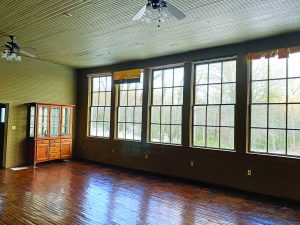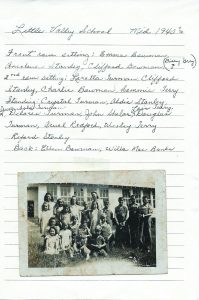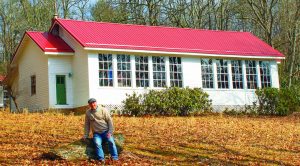
Located at 880 Little Valley Road in Carroll County, within Meadows of Dan, is an historic treasure that is getting a second chance to shine.
It was during the early 1900’s when Carroll County’s schoolboard recognized the need for additional schoolhouses to serve the growing community. The project eventually saw the construction of several schools, built on carefully selected sites, so children would not have to walk more than five miles from their homes along the dirt roads and animal trails. One of these sites, located at milepost 185 on the Blue Ridge Parkway, became known as the Little Valley Schoolhouse.
Construction on the schoolhouse began in 1929 when the Jessup family donated the land to the School Board of Carroll County. In turn, Carroll County provided funds to build the schoolhouse. Local residents provided the needed labor and a nearby sawmill provided the building materials, most of which were sourced from local oak and chestnut trees. It was a genuine community effort, meant to provide opportunities for the children of the families living there.
The Little Valley Schoolhouse originated as a Settlement School, which was a community establishment born from the English/American Settlement movement. The movement, which began in the 1880s and peaked around the 1920s, sought to bring the rich and the poor of society together in both physical proximity and social interconnectedness.
Originally envisioned for urban areas, it was Susan Chester, a graduate of Vassar College, who wanted to apply the Settlement idea to the more rural communities of Appalachia. She considered the people of rural Appalachia to be “the purest Americans to be found”. Though other types of community centers were created as part of this movement, schools also became part of the effort.
The story of its inspiration, however, is not the only historic credential that can be claimed by the Little Valley Schoolhouse. Even the architectural design of the building has historic significance. The layout and all its dimensions were originally taken from a book called “Community School Plans”, published in 1924 by the Rosenwald Foundation, which had strong philanthropic ties to the Settlement movement.
 Director S.L. Smith drew up all the designs, providing separate blueprints for buildings that faced east-west and buildings that faced north-south. This was to make best use of natural light. Plans were also included for schools of different sizes. “Community School Plans”, however, was not the first publication of its kind. The Tuskegee Institute had published a pamphlet of school designs just nine years earlier.
Director S.L. Smith drew up all the designs, providing separate blueprints for buildings that faced east-west and buildings that faced north-south. This was to make best use of natural light. Plans were also included for schools of different sizes. “Community School Plans”, however, was not the first publication of its kind. The Tuskegee Institute had published a pamphlet of school designs just nine years earlier.
The Tuskegee Institute, led by Booker T. Washington, had originally published the pamphlet in 1915, featuring designs created by Professors R.R. Taylor, Director of the Department of Mechanical Industries, and W.A. Hazel, of the Division of Architecture. The Tuskegee pamphlet was published for the purpose of having a literal blueprint for establishing schools for black children in the rural South.
 In 1920, the two organizations joined hands and moved forward under the Rosenwald Foundation, combining not only their forces, but also their missions. At the encouragement of Booker T. Washington, Rosenwald setup a foundation for seed money to promote the collaboration between black and white children. This fund was used primarily by the people of the Blue Ridge Mountains, even in the poor, rural communities that didn’t have any black students.
In 1920, the two organizations joined hands and moved forward under the Rosenwald Foundation, combining not only their forces, but also their missions. At the encouragement of Booker T. Washington, Rosenwald setup a foundation for seed money to promote the collaboration between black and white children. This fund was used primarily by the people of the Blue Ridge Mountains, even in the poor, rural communities that didn’t have any black students.
In the end, the Little Valley Schoolhouse was a direct result of the partnership between African-American leader, educator, and philanthropist Booker T. Washington, and philanthropist Julius Rosenwald, co-owner and president of Sears, Roebuck and Company.
 The Little Valley Schoolhouse opened its doors in 1930 for grades One through Six. It consisted of two classrooms and an outhouse located at the rear of the property. A small spring fed a stream that ran alongside the building where children would dip their pails for water and there were two wood potbelly stoves to provide the heat during the winter months. There was no electricity. Only natural lighting was available.
The Little Valley Schoolhouse opened its doors in 1930 for grades One through Six. It consisted of two classrooms and an outhouse located at the rear of the property. A small spring fed a stream that ran alongside the building where children would dip their pails for water and there were two wood potbelly stoves to provide the heat during the winter months. There was no electricity. Only natural lighting was available.
(above: school children circa 1945).
Little Valley Schoolhouse was also host to one of the most highly respected instructors in Southern Virginia. Having received his degree and license to teach at age 17, John Duncan taught for fifty-four consecutive years in the Carroll County school district. All but fifteen of those years were spent teaching at the Pine Knot and Little Valley schools, where the black board he used was three planks nailed together and painted black.
Mr. Duncan was considered a remarkable person in all aspects of his life from teaching to religion, to farming. He was well regarded in the community for always being well-groomed and gracious; often riding on horseback from his farm in Laurel Fork to Little Valley. The history of John Duncan remains prominent in local history, as well as in the minds of those few students still surviving today.
The schoolhouse remained in operation until 1953 when the property was sold back to Johnnie S. Jessup and Leon Jessup for the sum of $315. Eventually, however, it was repossessed by the bank and remained vacant for many years.
 Throughout its history, the schoolhouse roof was maintained in good condition. Also, the storage of hay inside the classrooms kept the interior dry. Despite these measures, however, the building succumbed to the forces of time and became dilapidated. A buyer could not be found due to its condition. In 2018, however, fortunes changed for the historic building. Michael Lucas, of Meadows of Dan, purchased the Little Valley Schoolhouse to restore the property and preserve it as a unique piece of history. (above: MIchael Lucas sitting in front of the Little Valley Schoolhouse)
Throughout its history, the schoolhouse roof was maintained in good condition. Also, the storage of hay inside the classrooms kept the interior dry. Despite these measures, however, the building succumbed to the forces of time and became dilapidated. A buyer could not be found due to its condition. In 2018, however, fortunes changed for the historic building. Michael Lucas, of Meadows of Dan, purchased the Little Valley Schoolhouse to restore the property and preserve it as a unique piece of history. (above: MIchael Lucas sitting in front of the Little Valley Schoolhouse)
 During the restoration period, Mr. Lucas, former students, and members of the community visited the schoolhouse to provide classroom photographs and stories of the past. Many historical facts were also derived from news articles published over the years in the Carroll County News. These stories have been archived electronically and are available online.
During the restoration period, Mr. Lucas, former students, and members of the community visited the schoolhouse to provide classroom photographs and stories of the past. Many historical facts were also derived from news articles published over the years in the Carroll County News. These stories have been archived electronically and are available online.
In 2002, the National Trust for Historic Preservation identified Rosenwald Schools near the very top of the most endangered and historical properties in this country’s history. In 2015 the National Trust classified the Rosenwald schools as a National Treasure. Less than ten percent of these schools still remain. Many Rosenwald schools have been either destroyed, left to decay beyond recognition, or were burned.
The state of Virginia has recently designated the Little Valley Schoolhouse as a historical structure, and the application is in process to make the schoolhouse a National Landmark.
For more information about the schoolhouse, its restoration, or to schedule a tour, contact Mr. Lucas by emailing noisecontrolengineer@gmail.com.
Little Valley Schoolhouse • Michael Lucas
noisecontrolengineer@gmail.com
